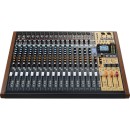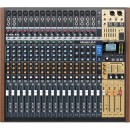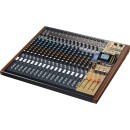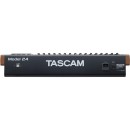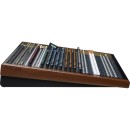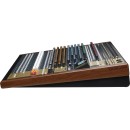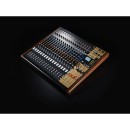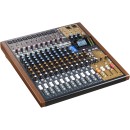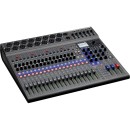TASCAM Model 24: A Comprehensive Review
- 24-Track Multi-Track Recording and Playback
- Integrated 22-Channel Mixer with Analog Feel
- 22-In/24-Out USB Audio Interface
- Comprehensive EQ and Compression on Each Channel
- Flexible Routing Options
- Built-in Effects Processor
- Bluetooth Connectivity for Streaming
- High-Resolution 24-bit/48kHz Audio Quality
- SD Card Storage for Recording
- User-Friendly Interface with Large Color Display
Detailed Review of Specifications, Advantages, and Disadvantages
The TASCAM Model 24 is a versatile all-in-one solution designed for musicians, producers, and live sound engineers. Combining the functionality of an analog mixer with a digital recorder and USB audio interface, the Model 24 offers a seamless blend of classic and modern audio technologies. Its intuitive layout features 22 channels, each with its own fader, EQ, and built-in effects, allowing for precise control over live performances and studio recordings.
The onboard 24-track recorder captures audio directly to an SD card, making it easy to record live shows or multi-track studio sessions without the need for a computer. For those who prefer digital workflows, the Model 24 also functions as a 22-in/24-out USB audio interface, compatible with all major DAWs. This flexibility ensures that users can integrate the mixer into any setup, whether they're recording, mixing, or performing live.
Additional features include a built-in metronome, Bluetooth connectivity for wireless audio streaming, and a rugged design suitable for both studio and stage environments. With its combination of robust features and user-friendly interface, the TASCAM Model 24 stands out as a powerful tool for anyone serious about audio production and live sound.
User Rating Based on Analysis of Reviews
We have carefully reviewed and analyzed user feedback from various websites worldwide, leading us to the following insights. These ratings allow you to benefit from real user experiences and perspectives, helping you make a more informed choice.
Purchase Value
85% of users were satisfied with the purchase value of the TASCAM Model 24. They appreciated its versatile features, combining a mixer, recorder, and USB interface, which they found offered significant convenience and saved them from having to buy multiple devices. Users often mentioned that the price was reasonable considering the range of functions it provided, and many highlighted the cost-effectiveness for home studios and small recording setups.
15% of users were dissatisfied with the purchase value, primarily due to the cost compared to other products in the market. Some felt that while it offered multiple functions, it did not excel in any particular area, which led them to question if the price justified its performance. A few users also pointed out the lack of features like motorized faders and more advanced digital processing options, which they expected at this price point.
Quality of Materials
80% of users were satisfied with the quality of materials used in the TASCAM Model 24. They reported that the mixer felt robust and durable, with a solid build that suggested longevity. Users appreciated the tactile feel of the knobs and faders, which they described as smooth and responsive, enhancing their overall experience.
20% of users expressed dissatisfaction with the quality of materials. Some users mentioned that the plastic components felt less premium than expected, which led to concerns about long-term durability. There were also occasional reports of faders and knobs feeling loose or developing issues over time, which detracted from the perceived quality.
Ease of Use
90% of users found the TASCAM Model 24 easy to use. The intuitive layout and straightforward controls were frequently praised, making it accessible even for those new to audio production. Users appreciated the clear labeling and logical arrangement of functions, which minimized the learning curve and allowed them to focus more on the creative aspects of their work.
10% of users had difficulties with the ease of use. Some reported that the interface, while simple, was not as user-friendly as they expected, especially for advanced features which required frequent referencing of the manual. Additionally, a few users mentioned that initial setup was not as intuitive as they hoped, leading to frustration.
Sound Quality
87% of users were satisfied with the sound quality of the TASCAM Model 24. Many highlighted the clarity and warmth of the audio output, which they found comparable to more expensive models. Users appreciated the clean preamps and the ability to capture detailed recordings, making it suitable for both live performances and studio work.
13% of users were dissatisfied with the sound quality, noting that they experienced some noise issues and interference, particularly at higher gains. A few users felt that the output lacked the depth and richness they expected, especially when compared to dedicated high-end audio equipment.
Versatility
92% of users praised the versatility of the TASCAM Model 24. They appreciated being able to use it as a mixer, recorder, and USB audio interface, which they found particularly useful for different scenarios, from live events to studio recordings. The ability to record directly to an SD card was highlighted as a major plus for on-the-go projects.
8% of users felt the product was not versatile enough for their needs. Some found the lack of certain advanced features, like onboard effects processing, limited its use in more complex recording setups. Others noted that while it served multiple functions, it did not perform as well as specialized devices in any specific area.
Portability
75% of users were satisfied with the portability of the TASCAM Model 24, appreciating its compact design that made it easier to transport than larger setups. They valued its ability to serve multiple roles while maintaining a relatively light form factor, which was convenient for mobile recording sessions.
25% of users found the mixer less portable than they hoped. They mentioned the weight and size as limiting factors, especially for those who needed to carry it around frequently. Some users also noted that while it was more portable than a full studio setup, it was not as easy to transport as other compact mixers available in the market.
Durability
83% of users were satisfied with the durability of the TASCAM Model 24. They noted that the sturdy construction and quality materials provided confidence that the device would withstand regular use. Many users mentioned that it held up well in various environments, from studios to live settings.
17% of users were concerned about the durability of the mixer. Some reported issues with components such as faders and knobs becoming loose or malfunctioning over time. Others expressed concerns about the plastic parts, which they felt could be more robust to prevent wear and tear.
Connectivity Options
88% of users appreciated the comprehensive connectivity options of the TASCAM Model 24. They highlighted the variety of inputs and outputs, which provided flexibility for different setups and allowed them to connect numerous devices simultaneously. The USB interface was particularly valued for its ease of integration with digital workstations.
12% of users were not satisfied with the connectivity options. Some felt that while there were many connections available, the lack of specific outputs such as ADAT or more digital inputs limited their ability to expand their setup. Others noted occasional issues with the USB connection, which could interrupt their workflow.
Recording Quality
86% of users were satisfied with the recording quality of the TASCAM Model 24. They reported clear and accurate recordings, with the onboard preamps providing sufficient gain and low noise. The ability to record directly to an SD card was frequently mentioned as a convenient feature that maintained high-quality audio capture.
14% of users were dissatisfied with the recording quality. Some users experienced issues with noise or interference, particularly in more complex recording settings. A few users also mentioned that while the quality was good, it did not match up to that of dedicated high-end recording equipment, especially for critical studio work.
Interface Design
84% of users were pleased with the interface design of the TASCAM Model 24. They found the layout intuitive and user-friendly, with controls that were easy to understand and operate. The clear labeling and logical arrangement of knobs and faders contributed to a smooth user experience, especially for live mixing.
16% of users were dissatisfied with the interface design. Some found the design to be somewhat outdated, with a lack of digital displays that could provide more detailed information. Others mentioned that the small size of some controls made them difficult to adjust precisely in live or fast-paced environments.
Customer Support
78% of users were satisfied with the customer support provided by TASCAM. They reported receiving prompt and helpful responses to their inquiries, with many users appreciating the assistance in resolving issues or answering technical questions. The availability of online resources and manuals was also noted as beneficial.
22% of users expressed dissatisfaction with customer support. Some reported delays in receiving responses, which was frustrating when dealing with urgent issues. Others mentioned that the support staff occasionally lacked detailed knowledge of the product, leading to less effective problem resolutions.
Software Compatibility
82% of users were satisfied with the software compatibility of the TASCAM Model 24. They appreciated how easily it integrated with various digital audio workstations, allowing for seamless recording and editing. Many users found that the drivers were easy to install and worked reliably across different operating systems.
18% of users encountered issues with software compatibility. Some experienced difficulties in setting up the device with certain DAWs, leading to compatibility issues or limited functionality. Others noted occasional problems with driver stability, which could disrupt their workflow during recording sessions.
Feature Set
89% of users were impressed with the feature set of the TASCAM Model 24. They valued the combination of mixer, recorder, and USB interface capabilities, which provided a comprehensive solution for various audio production needs. Users frequently mentioned the built-in effects and EQ options as useful additions that enhanced their recordings.
11% of users felt the feature set was lacking in certain areas. Some expressed a desire for more advanced digital features, such as motorized faders or more sophisticated effects processing. Others mentioned that while the existing features were useful, they did not always meet the demands of more complex production environments.
Aesthetics
81% of users were satisfied with the aesthetics of the TASCAM Model 24. They appreciated the professional look and design, which they found attractive and suitable for both studio and live settings. The clear labeling and organized layout also contributed to a visually pleasing user experience.
19% of users were not impressed with the aesthetics. Some found the design to be somewhat dated, lacking the modern appearance of other contemporary mixers. Others mentioned that while functional, the overall look did not match the sleekness they expected from a device at this price point.
Value for Beginners
91% of users found the TASCAM Model 24 to be a great value for beginners in audio production. They appreciated the intuitive controls and user-friendly design, which made it easy for newcomers to learn and experiment with audio mixing and recording. The comprehensive feature set was also seen as a great introduction to more advanced audio techniques.
9% of users felt that the mixer might be overwhelming for absolute beginners. Some mentioned that while it was accessible, the range of features could be intimidating for those with no prior experience, leading to a steeper learning curve than expected. Others noted that the initial setup could be challenging without prior knowledge or guidance.
Advanced User Suitability
79% of users found the TASCAM Model 24 suitable for advanced users. They appreciated its versatility and range of features, which allowed them to handle more complex production tasks effectively. The quality of the preamps and recording capabilities were often highlighted as suitable for professional settings.
21% of users felt the mixer was not fully suitable for advanced users. Some noted that it lacked certain high-end features, such as motorized faders or more sophisticated routing options, which limited its use in professional environments. Others mentioned that while it was capable, it did not match the performance of more specialized equipment available for advanced production work.
Reliability
84% of users considered the TASCAM Model 24 to be reliable. They reported consistent performance in both live and studio settings, with many users noting that it rarely experienced technical issues or failures. The reliability of the recording functions, especially the SD card recording, was frequently highlighted as a strong point.
16% of users experienced reliability issues. Some reported occasional problems with the USB interface or the SD card recording, which could lead to interruptions in their workflow. Others mentioned hardware issues that arose after extended use, such as malfunctioning knobs or faders, which affected their confidence in the device's long-term reliability.
User Manual Quality
77% of users were satisfied with the quality of the user manual provided with the TASCAM Model 24. They found it to be comprehensive and helpful, providing clear instructions and troubleshooting tips that made setup and operation easier. Many users appreciated the detailed explanations of features and functions.
23% of users found the user manual lacking. Some reported that the manual was not as detailed as they hoped, leading to confusion over certain features or setup procedures. Others mentioned that the manual could be more user-friendly, with simpler language or more diagrams to aid understanding, especially for beginners.
Live Performance Suitability
88% of users found the TASCAM Model 24 well-suited for live performances. They valued the mixer’s ability to handle multiple inputs and outputs, as well as its robust performance under live conditions. The intuitive layout and reliable recording options were also praised for their effectiveness in live scenarios.
12% of users felt the mixer was not ideal for live performances. Some mentioned that the lack of certain live-specific features, such as motorized faders or more advanced routing capabilities, limited its effectiveness in more demanding live environments. Others noted occasional issues with connectivity or interface stability during live shows.
Studio Recording Suitability
85% of users were satisfied with the TASCAM Model 24 for studio recording purposes. They appreciated the clear sound quality and versatile features, which allowed them to manage different aspects of recording and mixing within a single device. The ability to record directly to an SD card was often highlighted as a convenient option.
15% of users found the mixer less suitable for studio recording. Some felt that it lacked certain advanced features needed for professional studio work, such as more extensive digital processing options or higher-end preamps. Others mentioned that while it was functional, it did not provide the same level of precision or control as dedicated studio equipment.
Build Quality
82% of users were satisfied with the build quality of the TASCAM Model 24. They mentioned that the mixer felt solid and well-constructed, with materials that seemed durable enough for regular use. The sturdy build was often cited as a reason for trusting the product in both studio and live settings.
18% of users had concerns about the build quality. Some reported issues with the durability of certain components, such as knobs and faders, which they felt could have been made from more robust materials. Others noted that while the overall build was decent, certain parts did not meet their expectations for long-term use.
In the sections that follow, we will provide a thorough examination of the TASCAM Model 24's specifications, highlighting both its strengths and potential drawbacks. This detailed review aims to give you a complete understanding of what this digital mixer, recorder, and USB audio interface has to offer.
Pros:
- Versatile all-in-one solution combining mixer, recorder, and USB audio interface.
- 24-track recording capability directly to SD card.
- User-friendly interface with dedicated controls and visual feedback.
- Built-in effects and dynamic processing for each channel.
- High-quality preamps and A/D converters for clear sound.
- Seamless integration with DAWs via USB connection.
Cons:
- Limited editing and mixing capabilities compared to dedicated DAW software.
- Relatively bulky and heavy, not the most portable option.
- No motorized faders, which may be a drawback for some users.
- Higher price point compared to simpler mixers or standalone recorders.
- Limited onboard storage options, relying on SD cards for recording.
General
| Form Factor | Desktop |
|---|---|
| Number of Tracks | 24 (22 Inputs + Stereo Mix) |
| Maximum Simultaneous Tracks | 22x Recording |
| Maximum Sampling Rate | 48 kHz / 24-Bit |
The TASCAM Model 24 is designed as a Desktop mixer, which means it is compact and tailored for use on a desk or tabletop. This form factor makes it ideal for home studios, small recording setups, or live sound applications, providing easy access to controls and connections without requiring much space.Show More
With a Number of Tracks totaling 24, the Model 24 features 22 inputs plus a stereo mix. This allows users to connect multiple instruments and microphones simultaneously, making it suitable for recording bands, podcasts, or any multi-source audio project. The ability to manage a variety of audio sources enhances creativity and flexibility in the recording process.
The Maximum Simultaneous Tracks for recording stands at 22. This means that users can capture 22 individual audio inputs at once, which is essential for complex recordings where multiple instruments or vocalists perform together. This capability allows for a more dynamic and full sound in recorded projects.
When it comes to audio quality, the Maximum Sampling Rate of 48 kHz with a 24-Bit depth indicates the level of detail and fidelity in audio recordings. A higher sampling rate and bit depth contribute to clearer, more nuanced sound reproduction, making the TASCAM Model 24 suitable for professional audio applications. This specification ensures that recordings maintain high audio quality, capturing subtle details in performance and sound.
Signal Processing
| Gain/Trim Range | -10 dB to +40 dB (Channels 1 to 12) -20 dB to +30 dB (Channels 13 to 20) Mic Inputs: Up to 50 dB |
|---|---|
| High-Pass Filter | 100 Hz, 18 dB/Octave |
| EQ Parameters | Mono Channels: High: ±15 dB at 12 kHz (Shelving) Mid: ±15 dB at 100 Hz to 8 kHz, 0.55 Q (Semi-Parametric) Low: ±15 dB at 80 Hz (Shelving) Stereo Channels: High: ±15 dB at 12 kHz (Shelving) Mid: ±15 dB at 600 Hz, 0.55 Q (Notch/Peak) Low: ±15 dB at 80 Hz (Shelving) Graphic EQ: ±15 dB at 8 kHz ±15 dB at 4 kHz ±15 dB at 2 kHz ±15 dB at 1 kHz ±15 dB at 500 Hz ±15 dB at 250 Hz ±15 dB at 125 Hz |
| Built-In Effects | 7x Reverb 2x Mono Delay 1x Stereo Delay Chorus Flanger 2x Delay+Reverb 2x Chorus+Reverb |
The Gain/Trim Range is a critical feature that allows users to adjust the input level of audio signals. For channels 1 to 12, the range spans from -10 dB to +40 dB, while channels 13 to 20 offer a range of -20 dB to +30 dB. This flexibility enables the mixer to accommodate various microphone sensitivities and sound sources, ensuring optimal audio quality by preventing distortion or excessive noise.Show More
The High-Pass Filter operates at a cutoff frequency of 100 Hz with an 18 dB/Octave slope. This filter is essential for eliminating low-frequency rumble and handling noise, which can clutter the mix. By removing unwanted bass frequencies, it enhances clarity in vocals and instruments, ultimately leading to a more polished sound.
The EQ Parameters provide detailed control over the audio signal. For mono channels, users can adjust high frequencies at ±15 dB at 12 kHz, mid frequencies between 100 Hz and 8 kHz with a semi-parametric Q of 0.55, and low frequencies at ±15 dB at 80 Hz. Stereo channels have similar controls but with slight variations in mid-range settings. This level of EQ customization allows for precise tonal shaping, enabling users to highlight or attenuate specific frequency ranges to suit their mix.
The Graphic EQ further enhances the mixing capabilities by allowing adjustments across multiple frequency bands, each with a ±15 dB range. This feature is particularly useful for correcting feedback issues or tailoring the overall sound to fit specific performance settings.
Lastly, the Built-In Effects section adds creative possibilities to the mix with a variety of effects including seven types of reverb, multiple delay options, chorus, flanger, and combinations of delay and reverb. These effects enable users to enrich their audio productions, adding depth and character to the sound, making the TASCAM Model 24 a versatile tool for both live and studio applications.
Connectivity
| Analog Audio I/O | 20x 1/4" TRS Balanced Line Input 16x XLR 3-Pin Balanced Mic Input 1x 1/8" / 3.5 mm TRS Unbalanced Stereo Input 1x Stereo RCA Coaxial Unbalanced Input 1x 1/4" TRS Headphone Output 2x 1/4" TRS Subgroup/Bus Output 2x 1/4" TRS Monitor Output 1x 1/4" TRS FX Output 2x 1/4" TRS Control Room Output 2x 1/4" TRS Unbalanced Insert In/Out 2x XLR 3-Pin Balanced Output |
|---|---|
| Phantom Power | 48 V |
| Host Connection | 1x USB-B (Class-Compliant) |
| Host Connection Protocol | USB 2.0 |
| Other I/O | 1x 1/4" TS Remote Input |
| Wireless | Bluetooth |
| Wireless Connectivity | Bluetooth |
The TASCAM Model 24 offers a comprehensive range of analog audio inputs and outputs designed to accommodate various recording and mixing scenarios. The specifications indicate a total of 20x 1/4" TRS balanced line inputs, which are essential for connecting multiple instruments or audio sources with minimal noise interference. Additionally, the 16x XLR 3-Pin balanced mic inputs allow users to connect professional microphones, providing high-quality sound capture. The presence of a 1/8" TRS unbalanced stereo input and a stereo RCA coaxial unbalanced input offers further versatility for integrating consumer audio devices, such as smartphones or CD players.Show More
In terms of output options, the Model 24 features a 1/4" TRS headphone output for personal monitoring, ensuring that users can always hear their mix accurately. The 2x 1/4" TRS subgroup/bus outputs allow for flexible routing of audio signals, which is ideal for live performances or complex studio sessions. The additional monitor outputs enable users to connect external speakers for a better overview of the audio mix. Furthermore, the presence of insert points and the XLR outputs with phantom power capability means that the mixer can easily integrate external effects processors and condenser microphones, respectively.
The USB connectivity feature enhances the functionality of the Model 24 as a digital audio interface. With a USB-B connection compliant with USB 2.0 protocols, users can easily connect the mixer to computers for recording and playback. This connectivity is essential for modern audio production, allowing for seamless integration with digital audio workstations (DAWs). Additionally, the inclusion of Bluetooth wireless connectivity offers a convenient way to stream audio from mobile devices, enhancing the overall user experience and flexibility in various settings.
Performance
| Maximum Input Level | 1/8" / 3.5 mm Inputs: +8 dBV (Unbalanced, Stereo) Insert Return: +18 dBu Line Inputs: +22 dBu Mic Inputs: +10 dBu RCA Inputs: +8 dBV (Unbalanced) |
|---|---|
| Maximum Output Level | Monitor/FX/Subgroup/Control Room Outputs: +16 dBu XLR Main Outputs: +22 dBu |
| Headphone Output Power | 80 mW per Channel into 32 Ohms |
| Impedance | 1/8" / 3.5 mm Inputs: 10 Kilohms Insert Return: 10 Kilohms Insert Send: 100 Ohms Line Inputs: 22 Kilohms (Balanced) Mic Inputs: 1.8 Kilohms RCA Inputs: 10 Kilohms Control Room/FX/Monitor/Subgroup Outputs: 100 Ohms XLR Main Outputs: 100 Ohms |
The TASCAM Model 24 boasts impressive specifications that enhance its functionality as a digital mixer, recorder, and USB audio interface. Show More
The Maximum Input Level indicates the highest signal level that each input can handle before distorting. For instance, the line inputs can accommodate a maximum level of +22 dBu, which ensures that professional audio sources can be used without the risk of clipping. This is particularly important for maintaining audio quality during recording and mixing. The various input types, such as mic, line, and RCA, have different maximum levels, allowing for flexibility in connecting various audio devices.
In terms of Maximum Output Level, the Model 24 ensures that users can send strong audio signals to other devices. The XLR main outputs can deliver up to +22 dBu, which is suitable for connecting to professional-grade speakers or recording interfaces. This high output level is crucial for achieving a robust sound without unwanted noise or distortion.
The Headphone Output Power of 80 mW per channel into 32 Ohms indicates the power available for driving headphones. This level of power is sufficient for most studio monitoring scenarios, providing clarity and volume without compromising audio fidelity. The ability to adjust headphone levels independently is a significant feature for audio engineers when monitoring mixes.
Finally, the Impedance specifications across various inputs and outputs play a critical role in matching devices for optimal performance. For example, the mic inputs have an impedance of 1.8 Kilohms, which is standard for professional microphones, ensuring compatibility and efficient signal transfer. Understanding impedance helps users select the right equipment and achieve the best sound quality in their audio setups.
Digital Audio
| Audio File Formats | Recording: BWF, WAV Playback: BWF, WAV |
|---|---|
| Sample Rates | 44.1 / 48 kHz |
| Bit Depths | 16 / 24-Bit |
The TASCAM Model 24 offers a range of audio file formats for both recording and playback, enhancing its versatility for various audio projects. The supported recording formats include BWF (Broadcast Wave Format) and WAV (Waveform Audio File Format). These formats are widely recognized in the industry, ensuring compatibility with most audio editing software and digital audio workstations (DAWs). Playback support for these formats allows for seamless integration into different setups, making it easier for users to manage their audio files without needing to convert them.Show More
The sample rates of 44.1 kHz and 48 kHz available on the TASCAM Model 24 cater to different audio quality requirements. A sample rate of 44.1 kHz is standard for music production and is commonly used for CDs, while 48 kHz is often preferred for film and video work, as it aligns better with video frame rates. These options provide flexibility for users to choose the best sample rate for their specific application, ensuring high-quality recordings suitable for various uses.
Bit depth is another critical specification, with the Model 24 supporting 16-bit and 24-bit depths. Bit depth determines the amount of detail captured in the audio signal; 16-bit is typical for CD-quality sound, while 24-bit offers a higher dynamic range, making it ideal for professional studio recordings. The higher bit depth allows for greater precision in capturing the subtleties of sound, which is especially beneficial in complex audio environments. With these options, users can select the best settings to match their recording needs and desired audio quality.
Audio Storage & Playback
| Supported Media | USB Hard Disk Drive |
|---|---|
| Memory Card Slot | 1 x SDXC |
| Supported Media Capacity | SD: 512 MB Minimum to 2 GB Maximum SDHC: 4 GB Minimum to 32 GB Maximum SDXC: 64 GB Minimum to 512 GB Maximum |
| File System Support | SD: FAT16 SDHC: FAT32 SDXC: exFAT |
The TASCAM Model 24 provides versatile media support, allowing users to engage with various storage options for their audio projects. The Supported Media category indicates that the mixer is compatible with USB hard disk drives, giving users the flexibility to connect larger storage solutions for extended recording sessions. This feature is particularly useful for professional applications where significant amounts of data need to be captured and stored efficiently.Show More
Additionally, the Memory Card Slot specifies that the device includes a single SDXC card slot, which supports a range of SD card formats. This feature allows users to employ memory cards as a quick and portable way to record and transfer audio data. The capacity range for these cards varies by type: SD cards support a minimum of 512 MB up to a maximum of 2 GB, SDHC cards extend this range from 4 GB to 32 GB, and SDXC cards accommodate even larger capacities from 64 GB to 512 GB. This variety ensures that users can choose the appropriate card based on their recording needs and project length.
Moreover, the File System Support indicates the types of file systems that the Model 24 can read and write to, which includes FAT16 for SD cards, FAT32 for SDHC cards, and exFAT for SDXC cards. Understanding these file systems is essential, as they determine how data is organized and accessed on the storage media. Choosing the right file system can enhance compatibility with other devices and ensure efficient data management during audio production.
Compatibility
| OS Compatibility | macOS 10.11 macOS 10.12 macOS 10.13 Windows 7 Windows 8.1 Windows 10 |
|---|
The OS Compatibility feature indicates the operating systems with which the TASCAM Model 24 is compatible. This is crucial for users looking to integrate the mixer into their existing setups. The compatibility includes various versions of macOS (10.11, 10.12, and 10.13) and Windows (7, 8.1, and 10). Show More
Having multiple OS options means that users can seamlessly connect the Model 24 to a range of computers, allowing for flexibility in different environments, whether in a professional studio or a home setup. This broad compatibility ensures that users can utilize the digital mixer without the need for extensive changes to their current operating systems, making it easier to record, mix, and produce audio efficiently.
Power
| Power Requirements | AC Input |
|---|---|
| AC Input Power | 100 to 240 VAC, 50 / 60 Hz |
| Power Consumption | 52 W |
The Power Requirements section outlines the electrical specifications necessary for the TASCAM Model 24 to function effectively. This includes the voltage range and frequency, which indicates the device can operate within a wide range of AC inputs, specifically from 100 to 240 VAC. This versatility makes the mixer suitable for use in different countries with varying electrical standards.Show More
The Power Input specifies the type of power the device requires, which in this case is an AC input. This means that the TASCAM Model 24 is designed to be plugged into a standard electrical outlet, making it convenient for both studio and live sound applications.
Furthermore, the Power Consumption value of 52 W gives users an idea of how much electricity the device will draw during operation. A lower power consumption is generally more efficient and can lead to reduced energy costs over time. Understanding these specifications is crucial for ensuring that users can safely and effectively integrate the TASCAM Model 24 into their existing setups without overloading circuits or encountering power supply issues.
Physical
| Operating Temperature | 41 to 95°F / 5 to 35°C |
|---|---|
| Dimensions | 22.7 x 20.2 x 4.4" / 575.8 x 513.1 x 112.5 mm (with Side Panel) 20.3 x 19.8 x 4.4" / 514.6 x 502.9 x 112.5 mm (without Side Panel) |
| Weight | 22.0 lb / 10.0 kg |
The Operating Temperature specification indicates the range of temperatures within which the TASCAM Model 24 can function optimally. Operating within this range, from 41 to 95 degrees Fahrenheit (5 to 35 degrees Celsius), ensures that the internal components, including the mixer and circuitry, perform reliably without overheating or becoming damaged due to extreme cold. This is particularly important for users who may be working in various environments, such as studios, live venues, or mobile setups.Show More
The Dimensions feature provides the physical size of the TASCAM Model 24, both with and without side panels. The measurements, in inches and millimeters, indicate how much space the mixer will occupy. Understanding the dimensions is crucial for users who need to ensure that their workspace can accommodate the equipment, whether it’s in a studio rack or on a tabletop. The difference in dimensions with and without the side panels allows for flexibility in installation and setup, catering to various user preferences and space limitations.
Lastly, the Weight specification reveals that the TASCAM Model 24 weighs 22.0 pounds (10.0 kg). This is an important consideration for portability and transportability. A mixer of this weight may require additional effort to move, so users should be aware of the weight when planning for gigs or transport to different locations. The weight also gives an indication of the sturdiness of the unit, which can impact its durability and stability during use.
Packaging Info
| Package Weight | 28.7 lb |
|---|---|
| Box Dimensions (LxWxH) | 25.25 x 25 x 8.75" |
The Package Weight of 28.7 lb indicates the total weight of the TASCAM Model 24 when it is packaged for shipping. This weight can affect portability and ease of transport, especially for musicians or sound engineers who may need to move the mixer to different venues or locations. A heavier unit may suggest a robust build quality and durability, which is essential for handling various live performance conditions.Show More
The Box Dimensions (25.25 x 25 x 8.75") provide the physical size of the packaging that the mixer comes in. These dimensions are important for storage and shipping considerations. They give users an idea of how much space the mixer will take up and whether it will fit within their existing equipment setups. Larger dimensions might also imply that the mixer includes various accessories or features that contribute to its versatility in different audio production environments.
Customer Images
Videos
Customer Questions
How do I set up the TASCAM Model 24 as an audio interface with my computer?
To set up the TASCAM Model 24 as an audio interface, connect it to your computer using a USB cable. Ensure that the mixer is powered on. Download and install the necessary drivers from the TASCAM website. Once installed, select the TASCAM Model 24 as your audio input and output device in your computer's audio settings and your DAW (Digital Audio Workstation).
Why is my TASCAM Model 24 not recording to the SD card?
Ensure that the SD card is properly inserted into the SD card slot. Check that the SD card is formatted correctly (FAT32). If the SD card is new or used in another device, format it using the TASCAM Model 24 before recording. Also, verify that the track you want to record is armed and the record button is pressed.
How can I update the firmware on my TASCAM Model 24?
To update the firmware, download the latest firmware file from the TASCAM website. Copy the firmware file to an empty SD card. Insert the SD card into the TASCAM Model 24. Power on the device while holding down the 'Menu' button to enter firmware update mode. Follow the on-screen instructions to complete the update.
Why is there no sound coming from my TASCAM Model 24 speakers?
Check that all cables are securely connected. Ensure that the main fader and the channel faders are raised. Verify that the speakers are powered on and correctly connected to the main outputs. Also, ensure that the 'Mute' buttons are not engaged on the channels and the main output.
How do I set up multitrack recording on the TASCAM Model 24?
To set up multitrack recording, insert a formatted SD card into the SD card slot. Press the 'Menu' button and navigate to 'Rec Mode.' Select 'Multitrack.' Arm the tracks you wish to record by pressing their 'Rec' buttons. Press the 'Record' button followed by the 'Play' button to start recording.
Can I use effects while recording with the TASCAM Model 24?
Yes, you can use built-in effects while recording. To do this, select the desired effect using the 'Effect' knob. Adjust the effect send level on the channel strip and the master effect return level to apply the effect to your recording.
How do I connect external effects to the TASCAM Model 24?
To connect external effects, use the 'Aux Send' outputs to send the signal to the external effects unit. Return the processed signal back into the mixer using the 'Aux Return' inputs or any available line input channels. Adjust the send and return levels accordingly.
Why is my TASCAM Model 24 not recognized by my DAW?
Ensure that the TASCAM Model 24 is properly connected to your computer via USB and powered on. Verify that the correct drivers are installed. In your DAW, go to the audio settings/preferences and select the TASCAM Model 24 as the input and output device. Restart your DAW if necessary.
How do I play back recorded tracks on the TASCAM Model 24?
To play back recorded tracks, press the 'Menu' button and navigate to 'Rec Mode.' Select 'Multitrack.' Use the 'Rec Select' buttons to choose the tracks you want to play back. Press the 'Play' button to start playback. Ensure the channel faders are raised, and the 'Mute' buttons are not engaged.
How can I prevent feedback when using the TASCAM Model 24?
To prevent feedback, ensure that microphones are placed away from speakers. Lower the gain and volume levels if feedback occurs. Use directional microphones and point them away from speakers. Additionally, use the EQ controls to cut frequencies that are causing feedback.
Comparison
← SWIPE THE TABLE TO SEE MORE →
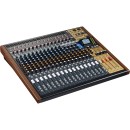
TASCAM Model 24 |
VS | ||
|---|---|---|---|
| Desktop | Form Factor | Desktop | - |
| 24 (22 Inputs + Stereo Mix) | Number of Tracks | 16 | - |
| 22x Recording | Maximum Simultaneous Tracks | 14x Recording | - |
| 48 kHz / 24-Bit | Maximum Sampling Rate | 48 kHz / 24-Bit | - |
